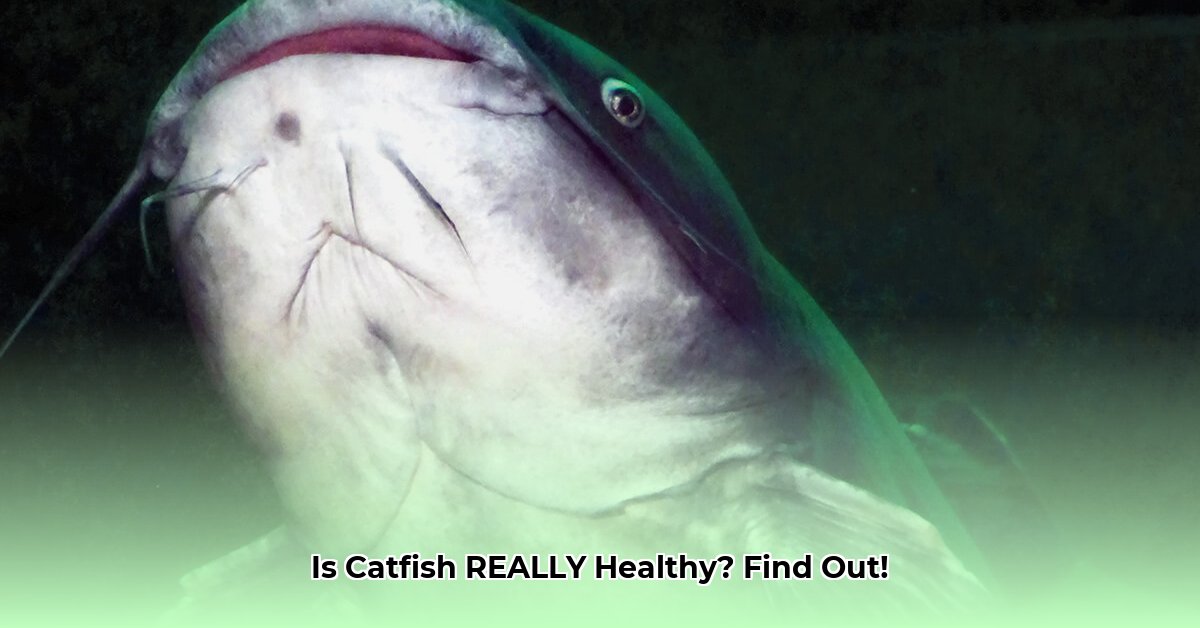So, is catfish good for you? It’s a tasty fish, but is it healthy? The truth is, it’s not a simple yes or no. This guide will give you the lowdown on catfish nutrition, covering the good, the bad, and how to make the best choices when you’re buying and cooking it. We’ll explore the nutritional profile, delve into the omega-3 and omega-6 fatty acid balance, examine the differences between wild and farmed catfish, address concerns about farming practices, and show you how to prepare it in ways that are both delicious and good for you. For comparison, learn about the health impacts of chicken skin [here](https://chaztin.com/is-chicken-skin-healthy). Get ready to become a catfish expert!
Health Benefits of Catfish
Let’s talk catfish! Are they good for you? The short answer is: it’s complicated. Like most foods, there’s more to the story than a simple “yes” or “no.” Let’s delve into the delicious details around the health aspect of catfish.
Catfish: A Nutritional Profile (Vitamins and Minerals)
Catfish is a good source of lean protein, crucial for muscle building and repair. A 3.5-ounce (100-gram) serving provides roughly 18 grams of protein. It’s also packed with vitamin B12, essential for healthy nerve function, cell metabolism, and DNA production, often exceeding the daily recommended value in a single serving. You’ll also find selenium, phosphorus, thiamine, and potassium.
Here’s a quick breakdown per 3.5-ounce (100-gram) serving:
- Calories: Approximately 105
- Protein: 18g
- Vitamin B12: Exceeds daily recommended value
- Selenium: 26% of the Daily Value (DV)
- Phosphorus: 24% of the DV
- Thiamine: 15% of the DV
- Potassium: 19% of the DV
However, the fat content and fatty acid profile can vary depending on whether it’s wild-caught or farmed, which brings us to an important point…
The Omega-3s vs. Omega-6s Puzzle (Fatty Acids)
Here’s where things get interesting. There’s a lot of talk about the ratio of omega-3s to omega-6s fatty acids in the diet. Both are essential fatty acids, but maintaining a balanced ratio is key for optimal health. Omega-3s are known for their anti-inflammatory properties and benefits for heart and brain health. The ideal balance remains a topic of ongoing debate, but many experts suggest aiming for a lower omega-6 to omega-3 ratio.
While catfish does contain both omega-3 and omega-6 fatty acids, it generally has a higher proportion of omega-6s. A 3.5-ounce serving typically provides around 200-300mg of omega-3s. This isn’t necessarily a deal-breaker, but it means you might want to consider incorporating other sources of omega-3s, like salmon, flaxseeds, or walnuts, into your diet to maintain a healthy balance. Approximately 250-500mg of combined EPA and DHA (both are types of omega-3) is considered adequate for general health.
Wild vs. Farmed: A Significant Difference? (Source Matters)
The nutritional makeup of your catfish dinner also depends on its origin. Wild-caught catfish might have a slightly higher omega-3 content due to their natural diet, but farm-raised catfish can still be a good source of other vitamins and minerals, depending on their feed.
However, there are potential downsides to farm-raised fish that need to be considered.
-
Contaminants: Farmed fish can sometimes have higher levels of contaminants due to farming practices.
-
Fat Content: Farmed catfish may have a higher fat content, including saturated fat, depending on their diet.
Farming Practices: To Worry or Not to Worry? (Sustainability)
Sustainable farming is key. If catfish is raised responsibly, its nutritional value is likely very similar to wild-caught catfish, and potential risks are minimized. However, some farming practices raise concerns.
-
Antibiotic Use: The routine use of antibiotics in fish farming can contribute to antibiotic resistance, a significant public health concern.
-
Environmental Impact: Poorly managed fish farms can pollute water systems and damage local ecosystems.
Look for labels that indicate the fish was raised sustainably, such as certifications from the Aquaculture Stewardship Council (ASC) or Best Aquaculture Practices (BAP). Choosing responsibly sourced fish helps protect both the environment and your health.
Cooking Up a Healthy Meal (Preparation Tips)
How you cook your catfish makes a substantial difference in its overall health profile. Baking, grilling, or broiling are healthier options that preserve nutrients and minimize added fats. Frying adds a lot of extra fat and calories, potentially negating some of the health benefits.
Here’s a comparison of cooking methods (per 3.5-ounce serving):
- Baked/Broiled: Lower in calories and fat.
- Grilled: Similar to baking/broiling, with potential for smoky flavor.
- Fried: Significantly higher in calories and unhealthy fats.
The goal is to enjoy that delicious catfish flavor without adding unnecessary baggage.
So, Is Catfish Healthy? The Verdict (Final Thoughts)
So, is catfish healthy? The answer, as you’ve probably gathered, is “It depends.” Catfish can be a nutritious part of a balanced diet, providing protein, vitamin B12, and other essential nutrients. However, it’s crucial to consider the omega-3/omega-6 ratio, be aware of potential contaminants from unsustainable farming practices, and choose healthy cooking methods.
Choosing sustainably raised catfish and preparing it in healthy ways is key to maximizing its benefits and minimizing potential risks.
Your Action Plan for Healthy Catfish (Consumer Guide)
Let’s make eating catfish a smart choice:
- Choose Wisely: Look for sustainably raised catfish. Certifications from ASC or BAP can provide assurance of responsible farming practices.
- Cook Smart: Bake, grill, or broil your catfish. Skip the deep fryer to significantly reduce unhealthy fat consumption.
- Portion Control: Enjoy catfish as part of a varied diet. Don’t overdo it.
- Stay Informed: Keep an eye out for new research on catfish and its nutritional value.
Remember, a healthy diet is about variety and balance. Enjoying catfish as one component of a larger, well-rounded eating plan is the best approach. Keep learning, keep exploring, and enjoy your food!
How to Choose the Healthiest Farmed Catfish Based on Farming Practices
Key Takeaways:
- US-farmed catfish is generally considered a sustainable and healthy protein source when farmed responsibly.
- Farming practices significantly impact the nutritional value and environmental footprint.
- Look for certifications and labels indicating sustainable farming methods.
- Choose cooking methods that minimize added oils and fats.
- Understand that while nutritional profiles are generally similar, wild-caught and farmed catfish may differ slightly in omega-3 fatty acid content.
Nutritional Powerhouse: Understanding Catfish
Catfish is a nutritional champion, boasting impressive levels of protein and vitamin B12. It’s also a decent source of selenium, a vital mineral for thyroid health. But, like any food, the story is more nuanced than a simple “good” or “bad” label. The nutritional content can vary considerably depending on the type of catfish and how it’s raised.
The Farm-Raised Factor: Making Informed Choices
This is where how to choose the healthiest farmed catfish based on farming practices becomes crucial. Farm-raised catfish dominates the market, and its environmental impact and nutritional value depend significantly on the farming practices employed. Sustainable aquaculture focuses on minimizing the environmental footprint. This includes responsible water management, feed sourcing, and waste disposal.
Environmental Impact: Beyond the Plate
Sustainable catfish farming aims to reduce its impact on ecosystems. Efficient water use and minimal chemical use are key indicators of responsible farming. However, the feed used to raise catfish is a significant factor to consider. Plant-based feeds are preferable to those relying heavily on wild-caught fish.
Decoding Labels and Certifications: Your Guide to Sustainable Catfish
Navigating the world of seafood labels can be tricky. Look for certifications from reputable organizations that verify sustainable farming practices. These certifications typically check for responsible water and land usage, ensuring minimal environmental harm. Transparency is key; choose producers who openly share information about their methods. Two of the most reliable certifications are:
- Aquaculture Stewardship Council (ASC): This certification ensures that the farm meets strict environmental and social standards.
- Best Aquaculture Practices (BAP): BAP certification covers various aspects of aquaculture, including environmental responsibility, social accountability, and animal welfare.
Omega-3s vs. Omega-6s: Finding the Balance
The ratio of omega-3 to omega-6 fatty acids is a frequent point of discussion. While farmed catfish generally contains less omega-3s than some wild-caught varieties, choosing sustainably raised fish helps maintain a healthier balance. This is because sustainable practices are less likely to compromise the fish’s natural diet and overall well-being.
Cooking Matters: Optimizing Nutrient Retention
Cooking methods significantly affect the nutritional value and overall healthiness of catfish. Baking, steaming, poaching or grilling are healthier alternatives to deep frying, which adds unhealthy fats. Keep cooking simple; let the natural flavors of the catfish shine.
Prioritizing Health and Sustainability: Your Action Plan
- Choose US-farmed catfish: It generally adheres to higher environmental and safety standards.
- Look for certifications: Support farms committed to sustainable practices.
- Read labels carefully: Look for information about feed sources and farming methods.
- Prepare catfish healthily: Opt for baking, broiling, poaching, steaming, or grilling instead of frying for maximum health benefit.
Seafood Watch offers a detailed analysis of various seafoods, including catfish and their sustainability, which can aid in informed purchasing decisions.
Catfish Farming Practices and Their Impact on Nutritional Value
Let’s dive into the delicious and nutritious world of catfish! But before we get to the yummy part, we need to understand something crucial: Catfish Farming Practices and Their Impact on Nutritional Value significantly influence the catfish you’re eating.
Nutritional Powerhouse?
Catfish is packed with protein, essential for building and repairing tissues. A 3-ounce serving provides approximately 22 grams of protein. It’s also a good source of vitamin B12, vital for nerve function and red blood cell formation. But here’s the catch (pun intended!): The nutritional profile isn’t always consistent. Think of it like this: a homegrown tomato tastes vastly different – and often better – than one from a massive factory farm. The same principle applies to catfish.
Wild vs. Farmed: A Nutritional Showdown
Wild catfish and farm-raised catfish can have different nutritional makeups. Wild catfish tend to have higher levels of omega-3 fatty acids, known for their heart-healthy benefits. However, farm-raised catfish might have a slightly different omega-3 to omega-6 ratio, and contamination concerns can arise depending on farming methods. So, what does this all mean? It’s not a simple “wild is better” answer.
- Omega-3 Content: Wild catfish generally have more omega-3s due to their natural diet.
- Contamination: Farm-raised catfish can be susceptible to contaminants if farming practices are not sustainable.
- Nutritional Consistency: Wild catfish nutrient profile can vary wildly based on their diets.
The Farming Factor: Sustainability Matters
This is where Catfish Farming Practices and Their Impact on Nutritional Value really come into play. Sustainable farming practices focus on minimizing environmental impact and improving fish well-being. These methods often lead to healthier fish with better nutritional profiles. Conversely, unsustainable practices can negatively affect the fish’s nutritional value and introduce potential contaminants.
What to Look For: Choosing the Best Catfish
Here are a few things to keep in mind when selecting your catfish:
- Look for certifications: Seek out catfish labeled with certifications indicating sustainable farming practices, such as ASC or BAP certifications. These certifications often ensure environmental responsibility and ethical treatment of the fish.
- Ask questions: Don’t hesitate to ask your fishmonger or grocery store about the sourcing of their catfish. Find out about farming methods.
- Read labels carefully: Check the labels for information on the origins and farming practices used. Transparency is key.
Cooking Matters Too
How you cook your catfish also affects its nutritional value. Baking, steaming, poaching or broiling are healthier options compared to deep-frying, which adds unhealthy fats and calories.
Healthy Catfish Cooking Methods:
- Baking: Season and bake your catfish in foil packets or a baking dish. This is simple and keeps the fish moist.
- Broiling: Broiling creates a crispy skin while keeping the flesh tender. Watch carefully!
- Grilling: Grilling is a tasty alternative, but it’s easy to overcook it.
- Steaming: Steaming preserves moisture and nutrients.
- Poaching: Poaching is a gentle method that keeps the fish delicate and flavorful.
Potential Risks: Things to Be Aware Of
While generally healthy, catfish can contain mercury, though usually at low levels. Pregnant women and young children should be extra mindful of their consumption and follow guidelines from organizations like the EPA (Environmental Protection Agency).
Key Takeaways:
- Sustainable farming practices are essential for ensuring a healthy and nutritious catfish supply.
- The nutritional composition of catfish can vary based on farming methods and environmental factors.
- Consumers should actively seek out sustainably raised and responsibly farmed catfish to prioritize both taste and health.
- Choosing healthy cooking methods enhances the nutritional value of catfish.
Sustainable Catfish Farming: A Responsible Approach
Cooking Methods and Their Effect on Catfish Nutrient Bioavailability
Key Takeaways:
- Catfish is a good source of lean protein and vitamin B12.
- Nutritional value varies depending on whether it’s wild-caught or farm-raised.
- Cooking Methods and Their Effect on Catfish Nutrient Bioavailability significantly impact its nutritional profile.
- Healthier cooking methods like baking, steaming, poaching broiling, and grilling preserve more nutrients.
- Fried catfish is higher in unhealthy fats and sodium.
- Choose sustainable and responsibly sourced catfish whenever possible.
Understanding Catfish Nutrition
Let’s dive into the nutritional specifics of catfish. It’s a lean protein powerhouse, boasting a healthy dose of vitamin B12—crucial for nerve function and red blood cell production. But here’s the twist: the nutritional profile isn’t static. It changes depending on where the catfish comes from and how it’s prepared.
Wild-caught and farm-raised catfish often differ in their nutrient composition. This difference can be substantial, impacting overall health benefits. Studies show inconsistencies in fat, protein, and mineral levels between the two. More research is needed to pinpoint the exact extent of these variations. However, some general trends are observed:
- Protein: Generally, both wild and farm-raised are good sources, but the exact amount can vary.
- Fats: Wild-caught may have a slightly better omega-3 to omega-6 ratio. But this often varies depending on the diet of the catfish.
- Minerals: Mineral content can vary based on the water and feed source.
The Impact of Cooking Methods
This is where things get really interesting. Cooking Methods and Their Effect on Catfish Nutrient Bioavailability are paramount. Think of it like this: a perfectly baked catfish fillet is a far cry from its deep-fried counterpart. Certain cooking methods impact the fat content.
- Frying: Frying can increase the fat by 50% or more.
- Baking, Grilling, or Steaming: These methods preserve moisture and nutrients and don’t require additional fats.
Frying significantly increases the fat and sodium content; it’s like adding extra baggage to an already nutritious meal. Baking, broiling, grilling, steaming and poaching, on the other hand, preserve more of those valuable nutrients, making them healthier choices.
Consider this a delicious nutritional balancing act. You want to maximize the good stuff while minimizing the less desirable aspects.
Choosing Your Catfish Wisely
Remember, not all catfish is created equal. Farm-raised catfish production varies in sustainability and practices. Look for labels indicating responsible sourcing and sustainable farming, such as ASC or BAP certifications. Support companies committed to transparency and environmentally sound practices. It’s a small step that makes a bigger difference.
Also, be aware of potential contaminants—like mercury—that can accumulate in fish. A varied diet rich in different nutrient sources is key. Don’t rely solely on catfish for everything.
Practical Steps for Healthier Catfish Consumption
- Choose your cooking method carefully. Baking, broiling, steaming, poaching and grilling are your friends. Fry sparingly, if at all.
- Look for clear labeling. Understanding the source of your catfish is crucial for making informed decisions. This includes looking for certifications on the packaging.
- Watch your portion sizes. Moderation is key to a balanced diet. A serving of 3-4 ounces is generally recommended.
- Diversify your diet. Enjoy a variety of seafood and other protein sources.
[Understanding the Impact of Cooking Methods on Catfish Nutritional Value]:https://www.healthline.com/nutrition/is-catfish-healthy
- Mini Bento Boxes For Packing Kids Snacks And Small Meals - December 27, 2025
- Small Bento Box Makes Packing Lunch Easy and Fun Again - December 26, 2025
- Adult Bento Box Lunch Ideas For Quick Healthy Portable Options - December 25, 2025










